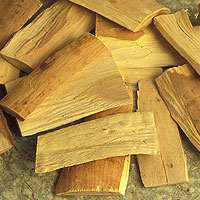Sandalwood
 © Martin Wall
© Martin WallHow It Works
The volatile oil contains high amounts of alpha- and beta-santalol. According to a test tube study, these small molecules possess antibacterial properties.2 This makes it a potential topical treatment for skin infections. Synthetic sandalwood oil does not contain these active ingredients. Internal use of sandalwood is approved by the German Commission E for the supportive treatment of infections of the lower urinary tract (usually the urinary bladder).3 However, clinical trials are lacking to support this use.
How to Use It
The German Commission E monograph suggests 1/4 teaspoon (1–1.5 grams) of the volatile oil for the supportive treatment of urinary tract infections.4 This should only be done under the supervision of a doctor. Treatment should not exceed six weeks. For external use, a few drops of sandalwood oil are dissolved in 6 ounces (180 ml) of water and applied directly to the infected area of skin several times daily.
Copyright © 2024 TraceGains, Inc. All rights reserved.
Learn more about TraceGains, the company.
The information presented by TraceGains is for informational purposes only. It is based on scientific studies (human, animal, or in vitro), clinical experience, or traditional usage as cited in each article. The results reported may not necessarily occur in all individuals. Self-treatment is not recommended for life-threatening conditions that require medical treatment under a doctor's care. For many of the conditions discussed, treatment with prescription or over the counter medication is also available. Consult your doctor, practitioner, and/or pharmacist for any health problem and before using any supplements or before making any changes in prescribed medications. Information expires December 2024.
